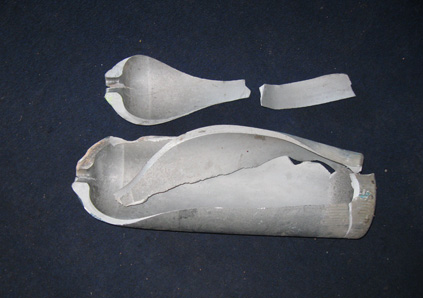Safe filling of portable aluminium alloy cylinders
Issued: 4 September 2009
Last Updated: 6 January 2017
Purpose
The purpose of this alert is to inform all businesses and people who fill aluminium alloy cylinders of the risks of death and injury from cylinder explosion.
An incident occurred in NSW in 2009 where a SCUBA cylinder exploded during the filling process causing serious bodily injury, including amputation.

Figure 1: Exploded cylinder.
Investigations by WorkCover NSW indicated that the cylinder involved in the incident was being filled correctly and that the cylinder had undergone visual, hydrostatic and appropriate non-destructive (eddy current) testing. The cylinder was manufactured in 1983/84. However, the cylinder involved in the incident was an 'at risk' cylinder.
A further incident has occurred to a SCUBA cylinder in NSW in August 2016. Please refer to the safety alert Gas cylinder manufactured from aluminium alloy 6351-T6 on the SafeWork NSW website for information on this incident.
Workplace Health and Safety Queensland (WHSQ) advises a risk assessment should be undertaken prior to any decision to fill 'at risk' cylinders to eliminate or minimise the risk from explosion.
Background
Ongoing catastrophic failures involving certain aluminium alloy cylinders worldwide, has prompted WHSQ to alert people using these cylinders of their potential hazards.
Alerts have been issued in 1993 and 1997 following explosive aluminium cylinder failures, however failures have continued to occur worldwide, resulting in severe injuries and damaged property.
Luxfer, a major manufacturer, has recorded a further seven ruptures since 1997, two of which involved Australian made cylinders.
Research has revealed that problems existed with cylinders manufactured from a certain composition of aluminium alloy. These problems cause a small percentage of cylinders to be rejected during routine inspections.
Problem cylinders
SCUBA cylinders manufactured from aluminium alloy 6351 are presently the main basis for concern. WHSQ strongly advises that all SCUBA cylinders manufactured from this alloy, and other aluminium alloy cylinders 15 years or older, be non-destructively examined annually for cracks and flaws in the neck fold and thread areas by competent and suitably-equipped people.
This should occur at the same time as annual internal visual and hydrostatic inspections by competent and suitably equipped people covered by Australian Standard AS 2030.1:2009 Gas Cylinders- General Requirements.
At risk SCUBA cylinders manufactured from aluminium alloy 6351 include:
- Luxfer aluminium alloy cylinders manufactured between 1972 and 1988 (check oldest hydrostatic test date stamped into cylinder)
- Luxfer aluminium alloy cylinder specification DOT SP6498
- Luxfer aluminium alloy cylinder specification DOT E6498, E7042, E8107, E8364, E8422
- CIG (Australia) aluminium alloy manufactured in or before 1990 (check oldest hydrostatic test date stamped into cylinder).
Faulty cylinders
Cylinders found to have unacceptable cracking or flaws during routine inspections must be rejected.
Safe operation basics
SCUBA cylinders should be maintained in a safe condition. The following tips will assist in achieving this condition:
- Ensure each cylinder is regularly inspected and known to be safe before filling.
- Do not permit a cylinder to be filled to a pressure greater than the working pressure stamped on the cylinder.
- Do not fit a taper threaded valve unit into a parallel threaded cylinder.
- Do not tamper with the valve unit safety valve fitting or rupture disc.
- Do not use a cylinder damaged by incorrect handling or storage and showing evidence of surface gouging, dents or partially broken fittings.
- Do not allow contaminants into your cylinder in the form of salt water or moisture.
- Do not allow a cylinder to come in contact with fire or temperatures above 150oC. This is particularly vital if repainting is considered using heat curing modern painting systems.
- Do not use any SCUBA cylinder which loses pressure or shows evidence of leakage, no matter how small. Leakage reduces calculated underwater time and may indicate imminent cylinder failure. If a cylinder leaks whilst filling, immediately cease filling, discharge the cylinder and evacuate the area.
- Cylinders should only be refilled in a manner that limits risk to personnel and property. SCUBA cylinders manufactured from aluminium alloy 6351 should be filled inside a suitable enclosure or in a way that prevents injury and property damage.
- Use proper cylinder filling equipment and procedures and refrain from fast filling. SCUBA cylinders manufactured from aluminium alloy 6351 should not be filled faster than 600 psi (40.8 atm) per minute.
- Never fill a cylinder without evidence of a valid test date. Most cylinder failures occur during the filling process.
- SCUBA cylinders should not be modified, for example by skimming off corroded neck material, unless the procedure is recommended by the manufacturer, in other documented procedures or to an applicable standard.
Advice regarding filling of cylinders can be found in section 2.3.6 of the Recreational Diving, Recreational Technical Diving and Snorkelling Code of Practice 2018 (PDF, 0.61 MB).
Further information
Read more about diving and snorkelling safety or contact WHSQ on 1300 362 128.